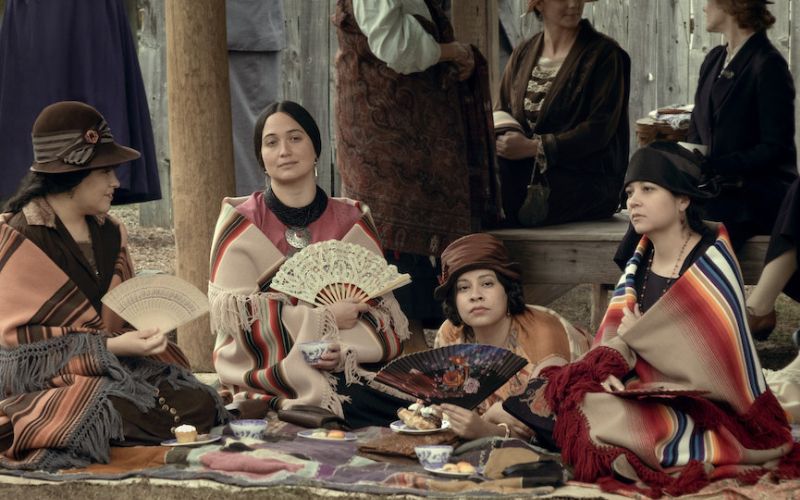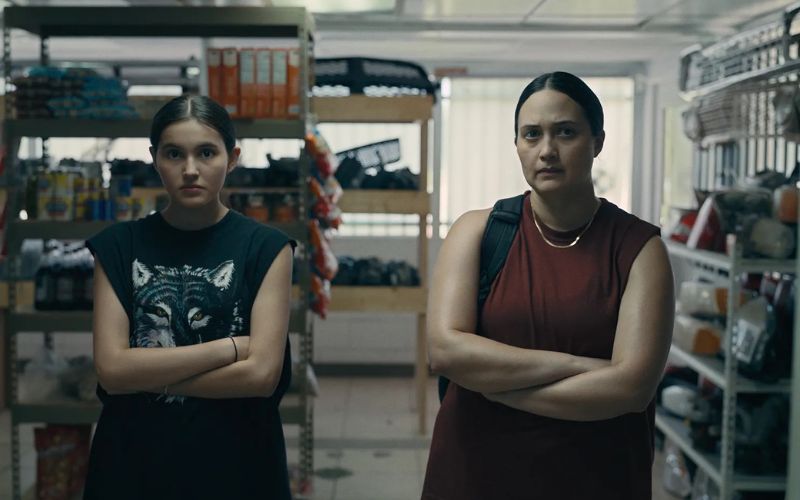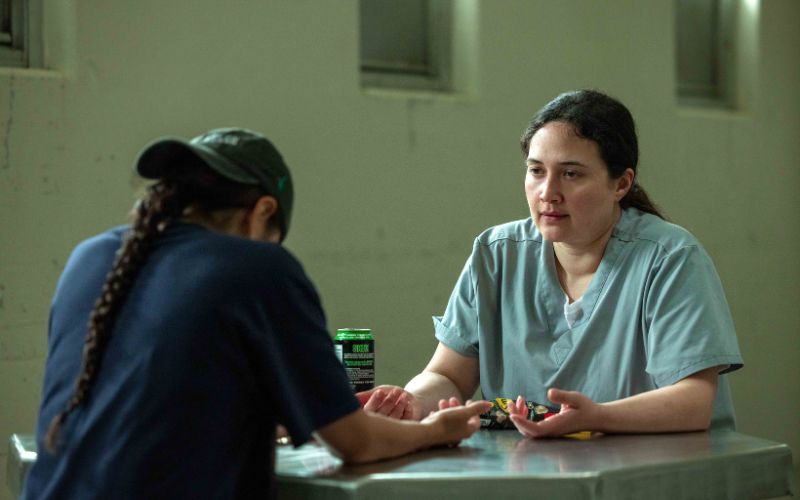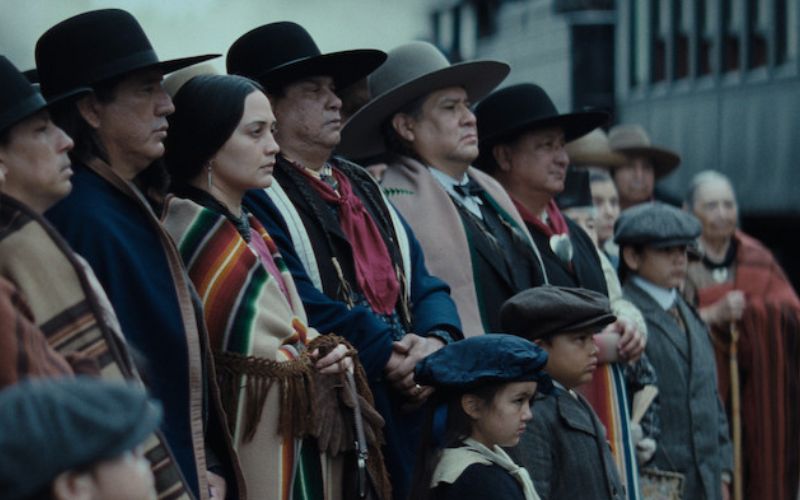
- Details
- By Jenna Kunze
Growing up, Lily Gladstone was presented with opposing visions for her acting career.
Her high school graduating class voted her "Most Likely to Win an Oscar," and her father predicted Gladstone would one day win an Academy Award, as well.
A few years later, an acting professor at the University of Montana offered a different view, telling Gladstone and her classmates they’d likely never become famous and should pursue theater purely out of a passion for the craft.
“I believed [my acting professor] more than I believed my dad,” Gladstone told Native News Online less than a week before the 96th annual Academy Awards, where she’s the first Native American ever nominated for a Best Actress Oscar. “Finding a purpose with what you love to do felt like the lesson there.”
For the 37-year-old Gladstone (Blackfeet and Nimíipuu), who grew up on the Blackfeet Indian Reservation in Montana before moving to Seattle at age 11, purpose has been baked into her work from the jump. Her purpose: educating non-Natives on true American history.
Long before she earned her Oscar nomination as Mollie Burkhart in Martin Scorsese's “Killers of the Flower Moon”—a role that has already earned her Golden Globe and SAG awards—Gladstone played a young Diné girl sent to an Indian boarding school in a performance at a Seattle-based theater company. Her character, based on a real-life woman, becomes a Navy nurse, while her brother enlists in the Marines as a Code Talker during World War II.
“[That performance] punched out the irony that this generation that had been taught not to speak their language at boarding school, then won the war for the United States because of the Code Talkers we had,” Gladstone said.
More than a decade into her career, she’s still teaching ironic histories. A good case study of Gladstone’s work might be to look at three recent productions, each set and filmed in Oklahoma, where the actor portrays three different Native women.
The first is “Flower Moon’s” Burkhart, a stoic Osage woman from the 1920s whose relatives were murdered by her white husband (Leonardo Decaprio) in pursuit of oil wealth.
The second is Jax, a queer Native woman at the center of director Erica Tremblay’s upcoming feature, “Fancy Dance.” Jax lives in the present-day on the Seneca–Cayuga Nation Reservation. In the wake of her sister’s disappearance, she’s tasked with caring for her niece Roki (Isabel Deroy-Olson), while also fighting to keep her in custody.
The third is Sterlin Harjo’s Hokti Sampson, a Muscogee mother and lapsed medicine woman grieving her son’s suicide while incarcerated for an unnamed crime in season two of “Reservation Dogs.”
Gladstone sees these three characters, and the larger societal snares they each battle—colonization, Missing and Murdered Indigenous Women, the Indian Child Welfare Act, and an overrepresentation of Natives in the criminal justice system—in conversation with one another.
 In “Fancy Dance” by director Erica Tremblay, Gladstone (on right) portrays a queer Native woman tasked with caring for her niece, played by Isabel Deroy-Olson (on left), whose mother has disappeared. (Photo: Fancy Dance Still)
In “Fancy Dance” by director Erica Tremblay, Gladstone (on right) portrays a queer Native woman tasked with caring for her niece, played by Isabel Deroy-Olson (on left), whose mother has disappeared. (Photo: Fancy Dance Still)
Particularly, Gladstone notes, Tremblay’s “Fancy Dance” works as a contemporary follow-up to “Killers of the Flower Moon.”
“It's the same issues, 100 years later, in the same land,” Gladstone said. The irony: a century after the FBI was created to save Native lives and investigate a string of murders on the Osage Nation, Indigenous people go missing or are murdered more than any other race in the country. The FBI, the agency responsible for investigating many of the crimes in Indian Country, has done little to stop the crisis.
“Time changes, but these systemic issues remain,” Gladstone said.
Harjo, the creator of the “Reservation Dogs” and also Hokti Sampson’s character, told Native News Online that the throughline in Gladstone’s recent roles is the authentic portrayal of Native people. That is only made possible, Harjo said, when two factors coalesce: when Native people write scripts themselves—or when non-Native filmmakers consult with Indigenous communities—and then Indigenous peoples play those Indigenous characters.
 On the groundbreaking series “Reservation Dogs”, Gladstone (right) portrayed Hokti Sampson, a Muscogee mother and lapsed medicine woman grieving her son’s suicide while incarcerated for an unnamed crime. (Photo: Shane Brown, Reservation Dogs)
On the groundbreaking series “Reservation Dogs”, Gladstone (right) portrayed Hokti Sampson, a Muscogee mother and lapsed medicine woman grieving her son’s suicide while incarcerated for an unnamed crime. (Photo: Shane Brown, Reservation Dogs)
“One thing that she's playing in all of those characters is a three-dimensional, strong Native woman,” Harjo said. “That's usually where non-Natives get it wrong. It's good writing—and also Osage involvement with “Killers of the Flower Moon”—that helped make sure [those characters were] accurate.”
Apple’s $200 million production of “Killers of the Flower Moon”, originally a book by journalist David Grann, relied heavily on involvement from Osage people. Cast members had months of Osage language coaching from elders, citizens were hired as artisans for costume design and cast as extras, and actors spent time community-building ahead of filming in Osage County. Gladstone said she modeled Mollie’s character off what she learned spending time in the community, observing typical behaviors of Osage women.
From Osage tribal members’ perspective, Gladstone is Mollie Burkart reincarnated.
Margo Gray, an Osage tribal citizen whose great grandfather, Henry Roan, was Mollie Burkhart’s first husband, called Gladstone’s work as her distant relative “spot on.”
“We were very cautious of how they were going to be portraying the women of our tribe, but she did such an incredible job,” Gray said. “Lily [is] such a seeker of knowledge, she wanted to make sure that she understood how Osage women conducted themselves. She attended many of our ceremonies, as invited, and asked a lot of questions.”
Osage women are known for their expressive eyes, reserved nature and regal movements—in part because their traditional yarn belted-clothing is somewhat restrictive, Gray said.
“The way I look at [Lily] now would be quasi-Osage, as if she’s an Osage woman,” Gray said of Gladstone’s performance.
 “We were very cautious of how they were going to be portraying the women of our tribe, but she did such an incredible job,” says Margo Gray, an Osage citizen with family ties to Mollie Burkhart. “Lily [is] such a seeker of knowledge, she wanted to make sure that she understood how Osage women conducted themselves.” (Photo: Bridget Shoenberger, Killers of the Flower Moon)
“We were very cautious of how they were going to be portraying the women of our tribe, but she did such an incredible job,” says Margo Gray, an Osage citizen with family ties to Mollie Burkhart. “Lily [is] such a seeker of knowledge, she wanted to make sure that she understood how Osage women conducted themselves.” (Photo: Bridget Shoenberger, Killers of the Flower Moon)
In addition to the Osage people, Gladstone drew inspiration from her own ancestors, particularly her namesake grandmother, in her portrayal of Mollie Burkhart.
“I anchored my perception [of Mollie] on my great-grandmother Lily, who would have been born around the same time as Mollie, and was alive during that turn of this century and the move from tradition to modernity,” Gladstone said.
Julie O’Keefe, an Osage citizen, was hired onto the production as the lead Osage Wardrobe Consultant, said the film’s production distilled down into feeling like a community project— “which is highly unusual.”
The professional costume designer had a front-row seat to Gladstone’s behind-the-scenes work learning Mollie’s language “to perfection.” She watched Gladstone work on set with Osage linguist Janis Carpenter, who would sit with the script in front of her as Gladstone read through her Osage lines and circle any mispronunciations for more practice.
“It was like watching a teacher grade a paper, and she rarely ever had any marks on her paper,” O’Keefe told Native News Online. “There wasn't anyone else—and I'm not overstating this—to play Mollie, but Lily.”
RELATED:
Lily Gladstone Makes History as First Native American Nominated for Oscar in Best Actress Category
Native Actress Lily Gladstone Wins SAG Best Actress Award on Saturday Night
On March 9, the Osage Nation is hosting an Oscars watch party. “Killers of the Flower Moon” is up for nine Oscars, including Best Picture, Best Costume Design, and Best Supporting Actor (Robert de Niro is nominated for his role as William Hale, the cunning orchestrator behind the Osage murders). But the Osage people are watching to see themselves acknowledged by an institution that, for 96 years, has never awarded an Oscar to a Native American or Alaska Native. They—and all of Indian Country—are watching for Gladstone to be the first.
“Lily is the one to represent us on stage because of her presence, and because of her silence, and because of her voice,” Harjo said. “She's the strongest, and we're all really excited to root her on.”
At Sunday’s Oscars, Gladstone will be up against some formidable competition in the Best Actress category: Emma Stone for “Poor Things,” Carey Mulligan for “Maestro,” Anette Benning for “Nyad”, and Sandra Hüller for “Anatomy of a Fall.” If Gladstone wins, she will be the first Native American actor ever—male or female—to win an Oscar statuette.
This week, as she spends time with her dog and attends a friend’s wedding back home, Gladstone is also reflecting on all of the Native actors who came before her.
“I don't like that there's oftentime this assumption that the first nominee in these categories is because there haven't been other performances that are nomination-worthy,” Gladstone said.
It’s those other performances that have inspired the actor’s own career: Gladstone remembers being blown away by Sheila Tousey’s (Menominee and Stockbridge-Munsee) performance in “Thunderheart” as a kid, and admiring the way Cree and Metis actress Tantoo Cardinal “eats the whole frame” every time she’s on camera. Of deserving Native male actors, Gladstone rapidly fired off three names: Graham Greene, the late Chief Dan George, and Wes Studi, who was given an Honorary Oscar by the Academy in 2019.
“The performances have always been there, and they’ve always been inspiring,” she said. “It's just that the industry hasn't been looking. It's not us that haven't caught up, it’s Hollywood.”
More Stories Like This
Q+A: Waha Delormier on Elevating Indigenous Representation in Fashion and FilmQ+A: Rob Pero on Indigenous Wisdom and Climate Advocacy in Upcoming Film 'The 7th'
Top Native Chefs Will Be Featured at American Indian College Fund NYC Event
Here's What's Going in Indian Country, April 19th— 25th
2024 Sundance Institute Native Filmmakers Lab Kicks Off April 24
Native Perspective. Native Voices. Native News.
We launched Native News Online because the mainstream media often overlooks news that is important is Native people. We believe that everyone in Indian Country deserves equal access to news and commentary pertaining to them, their relatives and their communities. That's why the story you’ve just finished was free — and we want to keep it that way, for all readers. We hope you'll consider making a donation to support our efforts so that we can continue publishing more stories that make a difference to Native people, whether they live on or off the reservation. Your donation will help us keep producing quality journalism and elevating Indigenous voices. Any contribution of any amount — big or small — gives us a better, stronger future and allows us to remain a force for change. Donate to Native News Online today and support independent Indigenous-centered journalism. Thank you.

